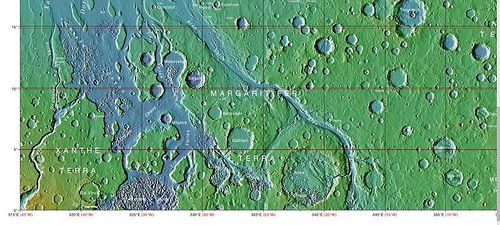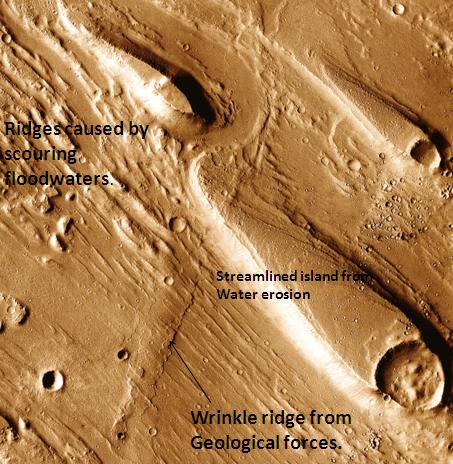Difference between revisions of "Ares Vallis"
m |
m (→See Also) |
||
| (13 intermediate revisions by 3 users not shown) | |||
| Line 1: | Line 1: | ||
| − | '''Ares Vallis''' (''Mars Valley'' in | + | |
| + | [[Image: Wikichaosmap.jpg|thumb|500px|left|Ares Vallis and surrounding features]] | ||
| + | |||
| + | [[Image: Erosion features in Ares Vallis.jpg|thumb|500px|right|Erosional features in Ares Valles]] | ||
| + | |||
| + | |||
| + | '''Ares Vallis''' (''Mars Valley'' in Latin) is a large valley that appears to have been eroded by ancient flows of water. It is located in the Oxia Palus quadrangle, at 10.4N and 25.8 W (334.2 E). Ares Vallis connects the mountainous [[Margaritifer Terra]] with the [[Chryse Planitia]] delta. The valley passes through the ancient [[Xanthe Terra]] highlands. Ares was named after the Greek name for Mars, the god of war; it appears to have been carved by fluids, probably water.<ref>https://planetarynames.wr.usgs.gov/SearchResults?target=MARS&featureType=Vallis, valles</ref> | ||
Ares Vallis was the chosen location for the 1996 [[Mars Pathfinder]] mission. The [[Sojourner]] rover explored the border of Ares Vallis with Chryse Planitia. | Ares Vallis was the chosen location for the 1996 [[Mars Pathfinder]] mission. The [[Sojourner]] rover explored the border of Ares Vallis with Chryse Planitia. | ||
| − | [[Image:Mars pathfinder.jpg|thumb|500px| | + | It has been argued that Uzboi Vallis, Ladon Valles, Margaritifer and Ares Valles, although now separated by large craters, once comprised a single outflow channel flowing north into Chryse Planitia.<ref>Parker, T.J., Clifford, S.m., and Banerdt, W.B. 2000. Argyre Planitia and the Mars global hydrologic cycle. LPSC XXXI, Abstract 2033.</ref> The source of this outflow has been suggested as overflow from the Argyre Crater, which was filled to the brim as a lake by channels (Surius, Dzigai, and Palacopus Valles) draining down from the south pole. If real, the full length of this drainage system would be over 8000 km, the longest known drainage path in the solar system. This long path for water flow has been named the Uzboi-Landon-Morava (ULM) system. Water from this system may have helped to form Ares Vallis.<ref>Carr, M. 1979. Formation of Martian flood features by the release of water from confined aquifers. J. Geophys. Res. 84, 2995-3007.</ref> <ref>Carr, M., G. Clow. 1981. Martian channels and valleys: their characteristics, distribution, and age. Icarus: 48 (1), 91-117.</ref> <ref>Grant, J., T. Parker. 2002. Drainage evolution of the Margaritifer Sinus region, Mars. J. Geophys. Res. 107, doi:10.1029/2001JE001678.</ref> <ref>Grant., J. et al. 2009. Geologic map of MTM-20012 and -25012 quadrangles, Margaritifer Terra region of Mars, U.S. Geol. Sur, Scientific Investigations Map 3041, scale 1:1,000,000.</ref> <ref>Rotto, S., K. Tanaka. 1995. Geologic/Geomorphic map of the Chryse Planitia region of Mars, U.S. Geol. Surv. Invest. Ser. Map I-2441, scale 1:5M.</ref> |
| − | [[Image:PIA01153 20594.jpg|thumb|500px| | + | |
| + | |||
| + | |||
| + | |||
| + | |||
| + | [[Image:Mars pathfinder.jpg|thumb|500px|right|A panorama of the Ares Vallis landing site of the [[Mars Pathfinder]] lander.]] | ||
| + | [[Image:PIA01153 20594.jpg|thumb|500px|right|Annotated panorama of the Ares Vallis landing site of the [[Mars Pathfinder]] lander. Annotations of surrounding features and rocks identified by the Pathfinder mission team.]] | ||
| + | |||
| + | == References == | ||
| + | {{Reflist}} | ||
| + | |||
| + | ==See Also== | ||
| + | *[[Water]] | ||
| + | |||
| + | *[[Mars Pathfinder]] | ||
| + | |||
| + | *[[Rivers on Mars]] | ||
| + | |||
| + | |||
| + | |||
| − | + | [[Category: Mars Atlas]] | |
Latest revision as of 16:04, 8 February 2019
Ares Vallis (Mars Valley in Latin) is a large valley that appears to have been eroded by ancient flows of water. It is located in the Oxia Palus quadrangle, at 10.4N and 25.8 W (334.2 E). Ares Vallis connects the mountainous Margaritifer Terra with the Chryse Planitia delta. The valley passes through the ancient Xanthe Terra highlands. Ares was named after the Greek name for Mars, the god of war; it appears to have been carved by fluids, probably water.[1]
Ares Vallis was the chosen location for the 1996 Mars Pathfinder mission. The Sojourner rover explored the border of Ares Vallis with Chryse Planitia.
It has been argued that Uzboi Vallis, Ladon Valles, Margaritifer and Ares Valles, although now separated by large craters, once comprised a single outflow channel flowing north into Chryse Planitia.[2] The source of this outflow has been suggested as overflow from the Argyre Crater, which was filled to the brim as a lake by channels (Surius, Dzigai, and Palacopus Valles) draining down from the south pole. If real, the full length of this drainage system would be over 8000 km, the longest known drainage path in the solar system. This long path for water flow has been named the Uzboi-Landon-Morava (ULM) system. Water from this system may have helped to form Ares Vallis.[3] [4] [5] [6] [7]


References
- ↑ https://planetarynames.wr.usgs.gov/SearchResults?target=MARS&featureType=Vallis, valles
- ↑ Parker, T.J., Clifford, S.m., and Banerdt, W.B. 2000. Argyre Planitia and the Mars global hydrologic cycle. LPSC XXXI, Abstract 2033.
- ↑ Carr, M. 1979. Formation of Martian flood features by the release of water from confined aquifers. J. Geophys. Res. 84, 2995-3007.
- ↑ Carr, M., G. Clow. 1981. Martian channels and valleys: their characteristics, distribution, and age. Icarus: 48 (1), 91-117.
- ↑ Grant, J., T. Parker. 2002. Drainage evolution of the Margaritifer Sinus region, Mars. J. Geophys. Res. 107, doi:10.1029/2001JE001678.
- ↑ Grant., J. et al. 2009. Geologic map of MTM-20012 and -25012 quadrangles, Margaritifer Terra region of Mars, U.S. Geol. Sur, Scientific Investigations Map 3041, scale 1:1,000,000.
- ↑ Rotto, S., K. Tanaka. 1995. Geologic/Geomorphic map of the Chryse Planitia region of Mars, U.S. Geol. Surv. Invest. Ser. Map I-2441, scale 1:5M.








